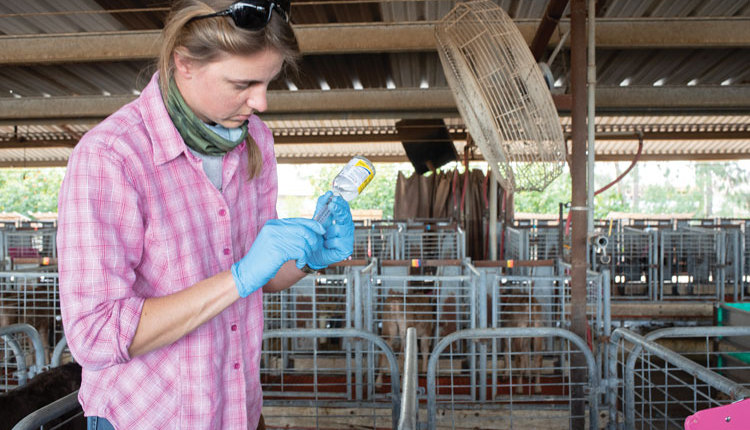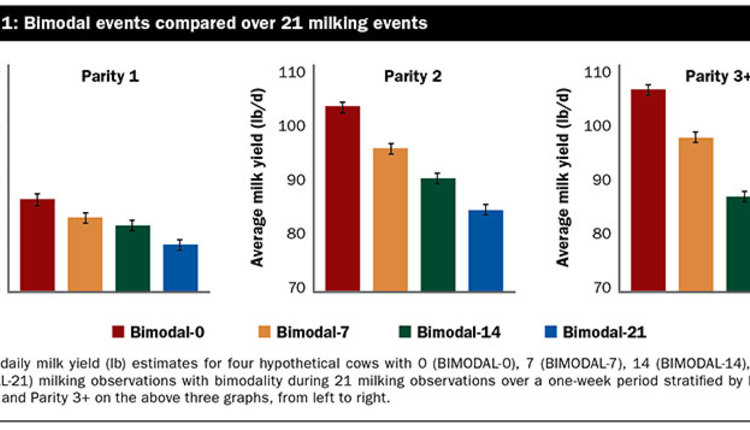The authors are with Quality Milk Production Services, Cornell University College of Veterinary Medicine.
The analysis of milk flow dynamics can provide valuable information for improving both milking efficiency and udder health. Among the numerous measures of milk flow, bimodality has been used extensively to assess the quality of premilking teat stimulation.
A bimodal milk flow curve takes place when an increasing milk flow rate is followed by a decreasing flow rate during the first two minutes of milking. This action is due to removal of the cisternal milk fraction before oxytocin allows the alveolar milk to reach the gland cistern.
The physiology of milk flow
Over 80% of the milk is stored in the alveolar compartment in the udder tissue. To facilitate its harvest, a reflex loop, known as the milk ejection reflex between a cow’s brain and the udder, must be activated.
Upon tactile stimulation, such as the suckling action from a calf, oxytocin is released from the brain, leading to ejection of milk from milk producing alveoli deep in the udder. The milk is then transported through milk ducts and accumulates in the gland and teat cistern. The speed of a suckling calf provides enough time for the signal to reach the brain, release oxytocin, and eject milk from the alveoli to replenish milk in the cistern as the calf is feeding.
When harvesting milk by machine milking, the milk ejection reflex is triggered predominantly by the tactile stimulation during udder preparation, such as forestripping and wiping of the teats. To facilitate enough time for the reflex to set in, a lag is required before the milking unit is attached. Current best practices suggest a minimum stimulation time of 10 to 20 seconds and a preparation lag time, or the time interval between first tactile stimulus and attachment of the milking unit, of 90 seconds.

Adequate stimulation is key
Recently, we showed that cows receiving a stimulation time of seven seconds were at higher risk of bimodality as compared to those that received 16 seconds of stimulation. This is consistent with work from Michigan State University showing that farms stimulating teats for a longer duration of time had a lower proportion of cows with bimodal milk let-down.
In a New York study, the investigators from Cornell University reported that the frequencies of bimodal milk flow curves in cows that received a preparation lag time of zero, 30, and 90 seconds were 21%, 14%, and 7%, respectively. Taken together, this suggests that the main risk for bimodality is inadequate stimulation and insufficient preparation lag time.
Cascading effects
Bimodal milk flow is associated with a reduction in milking efficiency and milk yield. Researchers found that cows receiving no or little stimulation before milking had more bimodality-type milking and longer milking machine on time. The negative association of bimodal milk flow with milk yield is supported by several studies.
There are also effects on teat health. Due to an inverse relationship between vacuum and milk flow, bimodality can elevate the vacuum-induced forces to the teats during the transient period of low or zero milk flow. These mechanical forces can cause congestion and edema of the teat tissue. Such tissue changes are thought to decrease the teats’ defense mechanisms, were associated with increased mastitis risk, and are considered to diminish animal well-being.
How to monitor milk flow
Traditionally, milk flow dynamics have been assessed with either portable or stationary electronic milk meters that measure continuous milk flow. Among the portable milk meters, the Lactocorder manufactured in Balgach, Switzerland, has gained significant popularity among veterinarians and milk quality consultants worldwide. Alternatively, instruments that record vacuum in the milking unit can also be valuable tools to indirectly assess milk flow dynamics.
Recently, we set out to investigate if the VaDia vacuum recorder (Biocontrol, Rakkestad, Norway) could serve to detect bimodality as assessed with the Lactocorder. We found satisfactory agreement between the two devices and concluded that both the Lactocorder and VaDia vacuum recorder are suitable measures to assess bimodal milk ejection in cows.
A few more considerations
There are a few points to consider when evaluating milk flow and timing of the premilking teat stimulation in a herd. Knowing the association of prestimulation and lag time with optimal milk flow, it is good to think about where in the current routine or parlor set up you expect the most challenges to an optimal milk flow.
Typically, in a parallel parlor with a territorial milking routine, the first and last cows of a territory are the most vulnerable to shortcomings in stimulation and preparation lag time. It is also important to evaluate a representative portion of the herd. Monitor both the high and low producing cows.
A physiological, uninterrupted onset of milk flow is key to efficient and gentle milking. There is a clear connection between insufficient premilking stimulation and bimodal milk flow. Accommodating the cows’ physiological requirements while improving parlor efficiency could be accomplished through, for example, a combination of manual and automated stimulation using inherent features such as the pulsator system.
Lastly, monitoring milk flow of a representative portion of the herd will help interpret the evaluation of the milking routine. It will also identify teat health risk factors and provide valuable information to improve milking efficiency and udder health.










